# 1 – Learning New Regulations and Compliance# 2 – Developing Expertise# 3 – Getting Ahead of the Competition Lead pipe replacement is an issue. Between 1900 and 1950, cities in all 50 US states installed over 9 million lead water service lines which, in many cases, were mandated for benefits including their longevity. With Read more
safety
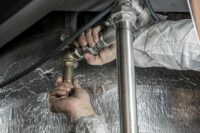
Table of Contents
Lead pipe replacement is an issue. Between 1900 and 1950, cities in all 50 US states installed over 9 million lead water service lines which, in many cases, were mandated for benefits including their longevity. With most of these pipes lasting between 75 and 100 years, many are still in use today, despite the fact that we’re now fully aware of how risky high water lead levels can be.
At the end of 2024, Joe Biden proposed the ‘Lead Replacement scheme’, which aims to oversee the complete replacement of American lead piping systems in the next ten years. While there has been some concern about the viability of the ten-year timeline, states, cities, and water utilities all agree that plumbing infrastructure needs to change. The question is, what does Biden’s proposal mean for the plumbing professionals?
Ultimately, replacements of dangerous lead piping are good news, making jobs safer and ensuring better customer-facing results. But it would be naive to assume that a total infrastructure overhaul won’t bring any industry disruption. Luckily, plumbers can easily adapt to any upcoming changes with the following vital tips.
# 1 – Learning New Regulations and Compliance
Biden’s proposal shines a light on an industry problem that’s been causing significant health problems for years. We already know that high levels of lead exposure can lead to everything from developmental problems to cardiac arrest, and it’s certainly contributed to the health debt outlined by Alex Kleyner in this article. As water utilities take a step towards healthier processes, it’s more important than ever for plumbing professionals to stay on top of new regulations and compliance requirements for ongoing client safeguarding.
To handle lead pipe replacements, plumbing professionals particularly need to seek the correct accreditation, as well as specific pipe replacement certifications.
# 2 – Developing Expertise
While the extent and speed required for this mass replacement task might seem overwhelming, the replacement of lead piping also opens the door to requirements for brand new plumbing expertise. This is true in terms of replacements themselves, which not every plumber will be authorized to carry out, but there are plenty of other learning opportunities waiting within this change.
For instance, plumbers who are experienced in identifying lead piping will inevitably see an increase in business over the next decade. Equally, with most lead pipes being replaced by alternatives such as copper, iron, and steel, plumbers with experience in these materials will typically perform better.
# 3 – Getting Ahead of the Competition
Lead pipe replacements may bring new possibilities for industry business over the coming years, but they’ll also initiate a competitive rush to secure clients. As well as ensuring their accreditation and experience, plumbing professionals will need to find alternative ways to get ahead and come out on top in the new plumbing world, including offering competitive pricing, providing complete pipe replacement packages, and generally ensuring exemplary service.
The plumbing industry is on the cusp of a big change, but plumbing professionals can easily keep up with the tide if they simply bear these tips in mind.
Sign up for our FREE Newsletter, https://mechanical-hub.com/enewsletter/
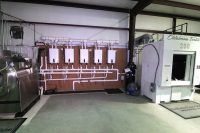
If you’ve ever started up a business, basically, any type of business, then you probably know that it feels like being thrown into a whirlwind of endless tasks, such as picking a location, training staff, figuring out why the website is glitching, and, oh yeah, making sure your plumbing doesn’t turn into a horror show Read more
If you’ve ever started up a business, basically, any type of business, then you probably know that it feels like being thrown into a whirlwind of endless tasks, such as picking a location, training staff, figuring out why the website is glitching, and, oh yeah, making sure your plumbing doesn’t turn into a horror show.
Now, sure, you might put some consideration into the bathroom design, but not really the plumbing, right? Well, plumbing isn’t exactly the shiny, exciting part of running a business, but it’s one of those things that can quietly ruin everything if it’s not handled right. From a residential standout (for your home), you know this, but it’s like that thought goes out the window the second it’s commercial plumbing.
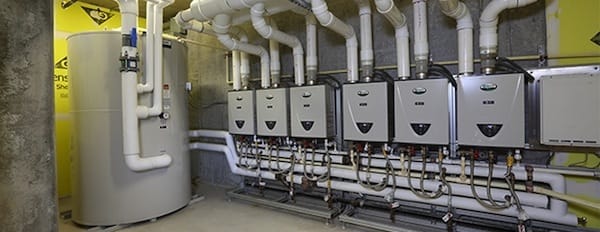
Thinking Commercial Plumbing Is Just Bigger Residential Plumbing
There’s this assumption floating around that commercial plumbing is basically residential plumbing on steroids. Wrong. Actually, commercial plumbing systems are like a different species—they have to handle way more pressure, higher volumes, and, let’s face it, a lot more wear and tear.
Actually, here’s a good example. So, just imagine opening a coffee shop. Those sinks are going to be used non-stop, the toilets will see more traffic than a rush-hour freeway, and every pipe behind the scenes has to handle that constant demand. So, if the plumbing isn’t built to keep up, it’s only a matter of time before the problems start, and when they do, they’ll bring everything to a screeching halt.
Forgetting That Plumbing Needs Maintenance Too
Okay, now here’s the thing: pipes don’t magically take care of themselves. But believe it or not, so many new businesses set up their plumbing and then totally forget about it until something goes wrong. And when it goes wrong?
Well, it goes really wrong. Just think of leaks, clogs, or even an unexpected indoor waterfall in the middle of your lunch rush. Even if you don’t own a cafe, but something else, like a carwash, well, that might be even more important because a business like that can’t run unless there’s plumbing.
Preventive maintenance might not sound glamorous, but it’s the difference between running a smooth operation and dealing with plumbing chaos. For example, if a business relies on pressure washing equipment, such as a car wash, even a tiny hiccup in water flow can be thrown off the whole day. Overall, some regular check-ups from a commercial plumber can catch those issues before they spiral out of control.
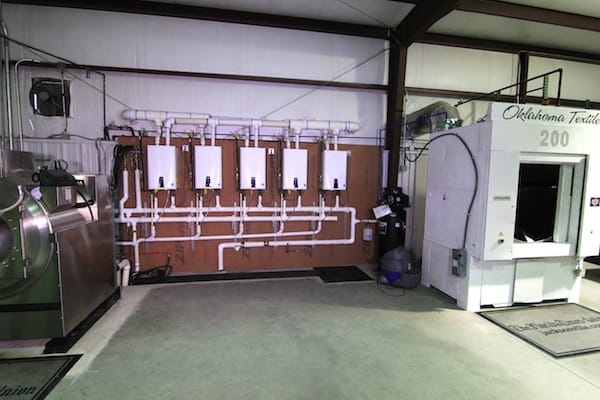
Going Cheap on Plumbing to Save Money
Look, saving money is important when starting out. Every penny counts, right? But trying to cut costs by hiring the cheapest plumber or opting for bargain-basement fixtures is like trying to build a house on a shaky foundation. It might hold up for a while, but when it collapses, it’s going to cost you way more to fix. Seriosuly, don’t make that mistake.
Ignoring Plumbing Codes and Regulations
In all honesty, nobody starts a business thinking, “Can’t wait to dive into local plumbing codes!” It’s not exactly fun. But at the same time, if you ignore them, well, that’s a massive mistake.
Basically, every city has its own set of rules, and they’re there for a reason, and it’s to make sure everything works safely and efficiently. So, just skipping this step might save some hassle in the short term, but it could land you in a heap of trouble later.

You know, as a plumbing engineer, it can be an extremely risky industry, and it pays for everyone to be aware of the risks that you can come into contact with by joining your day-to-day job. Working as a self-employed plumbing engineer involves infinitely more risks because, as a sole person, you are responsible for staying Read more
You know, as a plumbing engineer, it can be an extremely risky industry, and it pays for everyone to be aware of the risks that you can come into contact with by joining your day-to-day job. Working as a self-employed plumbing engineer involves infinitely more risks because, as a sole person, you are responsible for staying safe at all times and working through the correct safety laws and protocols put in place to ensure the safety of both yourself, your clients, and your working environment.
So whether you find yourself working on plans to install brand new plumbing on a new residential property, working with people to extend their homes, or your work takes you to a construction site, being aware of your responsibilities as a plumbing engineer can help to keep you safe at all times and ensure that the work you carry out as completed meets the highest standards and doesn’t pose any safety risks to the environment or to the users.
So what do you need to know, and what do you need to do to ensure your safety at all times?
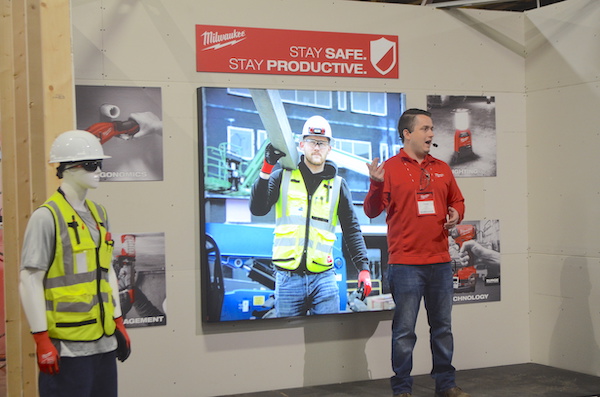
OSHA
OSHA, the cornerstone of workplace safety, controls and sets the standards for all health and safety initiatives for workplace employers and employees. For plumbers and plumbing engineers, specific sets of standards are in place and designed by OSHA to ensure that you can work safely, especially in hazardous environments. These standards include hazard protection, materials protection, and confined space regulations, providing you with a secure framework for your work.
Use Proper Tools and Equipment
As mentioned, during the course of your working day or week, you can face a range of different environmental scenarios and hazardous materials. Ensuring you’re using the correct tools and equipment for the job can help you minimize and reduce any potential risks or impacts of an incorrect job being carried out.
As a plumbing engineer, you will be responsible for designing, instaling and the maintenance of plumbing systems in various scenarios and environments, whether residential properties, chemical plants, hospitals, shopping malls, or anything else.
This means that you need to know what tools and equipment are required for the job at hand. So whether this is knowing the right gasket material types for the type of plumbing work and substances flowing through the plumbing or you need to understand the intricacies of navigating different construction materials to implement the right plumbing structure and connections and being able to understand the scope of the work can help you to ensure that you’ve got the right tools and equipment for use at all times.
PPE
Everyone is aware of what PPE is; however, due to the nature of the work you’ll be carrying out, ensuring you have the correct type of PPE for every single type of job is paramount for health and safety. As a self-employed engineer, the last thing you want is to be injured at work due to being negligent and then not being able to work for prolonged periods while you recover from accidents or injuries. The correct PPE will, of course, depend on the work you carry out, but at a minimum, this includes safety gloves, glasses, protective clothing, and even still cap boots to protect your feet while working.
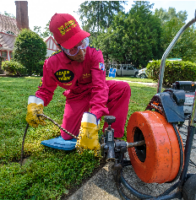
Being informed on the safety of drain cleaning and the dangers of it is very important when out in the field. Whether it be knowing what drain cleaning tools should be used for the job, what safety gear to wear and proper care for your equipment. In this blog post, we will discuss the dangers Read more
Being informed on the safety of drain cleaning and the dangers of it is very important when out in the field. Whether it be knowing what drain cleaning tools should be used for the job, what safety gear to wear and proper care for your equipment. In this blog post, we will discuss the dangers and safety measures that plumbers should be aware of.
 Dangers in drain cleaning
Dangers in drain cleaning
Dangers can be incurred if you use the wrong tool for the job. For example, if you have too small of a cable in too large of a drain or too large of a cable in too small of a drain, you can get the cable caught and you can cause damage to the equipment.
Also, if this should happen and you aren’t using a power feed with a guide tube on it to separate the user from the cable, there is the possibility that you can get a kink in the cable and it can grab the user by the hand or the arm—which can hurt!
Operating drain cleaning equipment should be more like using a drill than a hammer. The user should leverage the rotation of the cable and the cutter to eat its way through the obstruction, applying gentle, forward pressure. Using the right drain cleaning machine can significantly reduce the risks associated with drain cleaning.
Finally, because you are using electricity in the vicinity of water flow, make sure your electrical source is grounded with a properly functioning GFCI to protect from the possibility of an electrical shock.
PPE
Two-ply, leather gloves are highly recommended when using hand tools or drain cleaning equipment, but any kind of gloves that are specifically made for drain cleaning will work. Do not use rubber or cloth gloves, as you run the risk of getting them caught in the coils of the cable. If you must wear rubber gloves, wear them underneath the recommended leather gloves. Protective eyewear is also recommended for obvious reasons. You really don’t need anything else; it’s not necessary to garb up in a hazmat suit for drain cleaning.
Emergency response plan
We like to preach that preventative maintenance is always better than an emergency response plan.
Preventative maintenance would be a plan to regularly snake out drains because you know that if you don’t, they will have the propensity to back up.
The buildup of grease is particularly a problem in multifamily units and food service facilities, which causes emergency situations. For drains that are commonly affected by grease, we strongly recommend that companies invest in small, high-pressure water jetters, which are the right tools for the job.
Grease is not a job for a drum-style cable machine—it will poke a hole in the grease, but it will not remove the grease clog. We recommend preventative maintenance, using a high-pressure water jetter in at-risk pipes on a regular basis as opposed to waiting for them to overflow and creating an emergency. Handling clogged drains, especially when dealing with tough clogs like grease and sludge, requires the right equipment. Preventative maintenance is always easier, cheaper and more time efficient than emergency management.
When investing in basic drain cleaning equipment, companies don’t have to wait for a drain cleaning contractor to come out and do the job. Facility managers can include drain cleaning equipment into their long-term preventative maintenance programs. They will often find additional ways to put the equipment to use that they hadn’t thought of before.
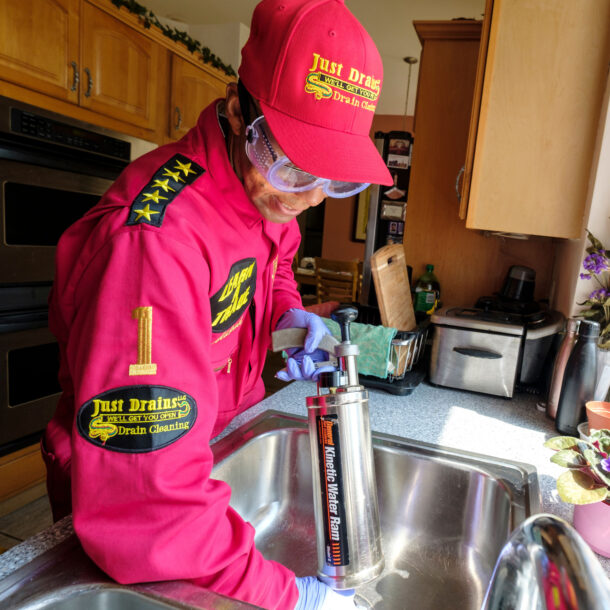
Safely and correctly operating and cleaning equipment and drains
The actual care and preventative maintenance of the drain cleaning equipment should not be overlooked. Every time the machine is used, we recommend that you clean it off and let the water drain out of it. Once the water has been completely drained, we recommend applying snake oil or lubrication to the cables. If you’re using a jetter, you should also clean out the hose and take proper care of the pumps.
Every 200 hours, perform routine maintenance on your equipment—check oil levels, seals, cables and drums. Five minutes of post-job maintenance on equipment will go a long way to preserving your equipment, sometimes for 10 years or more. Maintaining drain cleaning cables and tools is crucial for the longevity of your drain cleaning equipment.
Regular maintenance of your cleaning tools, from a simple sink cleaning hand tool to complex sewer cleaning equipment, ensures longevity and peak performance. Always check for debris that might have been left behind, clean out the drum, and ensure that water is properly drained after each use. Regular upkeep reduces the chances of blockages in your cleaning machine and guarantees that you’re always ready to handle even the toughest clogs.
Here at General Pipe Cleaners, safety is a top priority, which is why it’s important to understand the dangers of drain cleaning and how to perform the job safely.
Questions? Call the Drain Brains at 800-245-6200

Industry Report Examines Plastic Pipe Materials and Health Impacts The latest report from Safe Piping Matters covers upcoming research showing commonly used plastic pipe materials can release significant amounts of microplastics and nanoplastics into plumbing systems. It also provides a look at current studies examining how these and other tiny plastic particles affect human health Read more
Industry Report Examines Plastic Pipe Materials and Health Impacts
The latest report from Safe Piping Matters covers upcoming research showing commonly used plastic pipe materials can release significant amounts of microplastics and nanoplastics into plumbing systems. It also provides a look at current studies examining how these and other tiny plastic particles affect human health, including impacts on the gut, lungs, brain, and reproductive organs, as well as increasing risks from related toxins and pathogens.
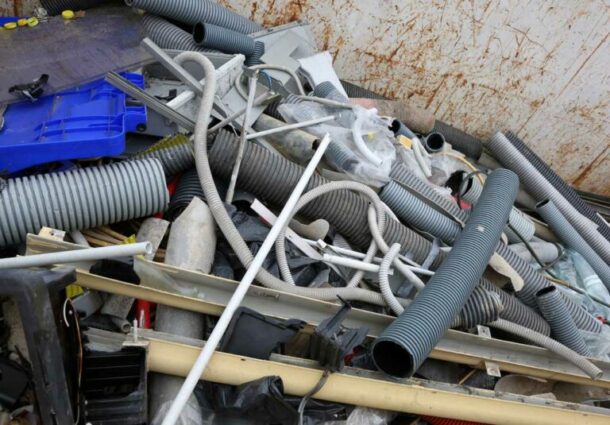
“The explosion of plastic pollution around the world continues to contaminate drinking water, food, and air with microplastics,” said Paul Hagar, Executive Director of Safe Piping Matters. “Our report shows why the plumbing industry needs to study the ways in which plastic pipe materials contribute to microplastic contamination.”
The report summarizes a study from Polish researchers who analyzed materials taken from water-transmission systems and found that plastic materials degrade “relatively quickly” as they age. Scans of the interior pipe surfaces showed peeling and flaking that released plastic particles into the water, adding to humans’ already significant exposure to ingested microplastics.
Plastic Pipes Microplastics and Health Impacts Report
The report also looks at issues such as chemical leaching in addition to shedding of micro- and nano- particles from common plastic pipe materials PVC (polyvinyl chloride), PE (polyethylene), PEX (cross-linked polyethylene), and CPVC (chlorinated polyvinyl chloride). It then reviews effects that medical studies have begun documenting on humans and/or lab animals, describing associations with cancer, cell death, tissue inflammation and damage, disruption of nervous function, reduced fertility, and other impacts.
“Architects, engineers, and contractors who care about the health and safety of building occupants should consider these issues when selecting piping materials,” says Hagar. “Emerging research does not support industry claims of rigorous testing standards and product safety.”

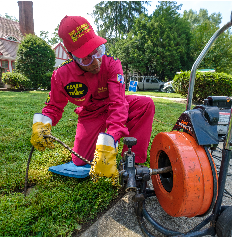 Dangers in drain cleaning
Dangers in drain cleaning